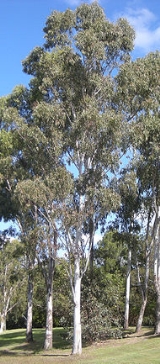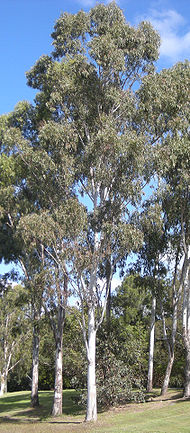
Eucalyptus tereticornis
Encyclopedia

Australia
Australia , officially the Commonwealth of Australia, is a country in the Southern Hemisphere comprising the mainland of the Australian continent, the island of Tasmania, and numerous smaller islands in the Indian and Pacific Oceans. It is the world's sixth-largest country by total area...
.
It has a great many common names, of which Forest Red Gum is perhaps the most widely known. Other common names include Bastard Box, Blue Gum, Flooded Gum, Grey Gum, Mountain Gum,Forest Red Gum, Queensland Blue Gum, Red Gum, Red Ironbark, Red Irongum and Slaty Gum.
Description
It grows to a height of from 20 to 50 metres, and a girth of up to 2 metres dbhDiameter at breast height
Diameter at breast height, or DBH, is a standard method of expressing the diameter of the trunk or bole of a standing tree. DBH is one of the most common dendrometric measurements....
. The trunk is straight, and is usually unbranched for more than half of the total height of the tree. Thereafter, limbs are unusually steeply inclined for a Eucalyptus species. The bark is shed in irregular sheets, resulting in a smooth trunk surface coloured in patches of white, grey and blue, corresponding to areas that shed their bark at different times.
It has narrow, lanceolate green leaves, from 10 to 20 centimetres long, and one to nearly three centimetres wide. Flowers occur in inflorescence
Inflorescence
An inflorescence is a group or cluster of flowers arranged on a stem that is composed of a main branch or a complicated arrangement of branches. Strictly, it is the part of the shoot of seed plants where flowers are formed and which is accordingly modified...
s of seven to 11 flowers.
Taxonomy
Specimens of E. tereticornis were first collected by First FleetFirst Fleet
The First Fleet is the name given to the eleven ships which sailed from Great Britain on 13 May 1787 with about 1,487 people, including 778 convicts , to establish the first European colony in Australia, in the region which Captain Cook had named New South Wales. The fleet was led by Captain ...
surgeon and naturalist John White
John White (surgeon)
John White was an English surgeon and botanical collector.White was born in Sussex and entered the Royal Navy on 26 June 1778 as third surgeon's mate. He was promoted surgeon in 1780, and was the principal surgeon during the voyage of the First Fleet to Australia...
from Port Jackson
Port Jackson
Port Jackson, containing Sydney Harbour, is the natural harbour of Sydney, Australia. It is known for its beauty, and in particular, as the location of the Sydney Opera House and Sydney Harbour Bridge...
in 1793, and published later that year by James Edward Smith
James Edward Smith
Sir James Edward Smith was an English botanist and founder of the Linnean Society.Smith was born in Norwich in 1759, the son of a wealthy wool merchant. He displayed a precocious interest in the natural world...
in Zoology and Botany of New Holland. It was later republished by Smith in his 1795 edition of A Specimen of the Botany of New Holland
A specimen of the botany of New Holland
A Specimen of the Botany of New Holland, also known by its standard abbreviation Spec. Bot. New Holland, was the first published book on the flora of Australia. Written by James Edward Smith and illustrated by James Sowerby, it was published by Sowerby in four parts between 1793 and 1795...
. Smith gave it the specific epithet tereticornis from the Latin
Latin
Latin is an Italic language originally spoken in Latium and Ancient Rome. It, along with most European languages, is a descendant of the ancient Proto-Indo-European language. Although it is considered a dead language, a number of scholars and members of the Christian clergy speak it fluently, and...
teretus ("terete", meaning circular in transverse cross-section) and cornu ("horn"), in reference to the horn-shaped bud cap.
It has had a fairly complex taxonomic history. Synonyms include:
- Eucalyptus tereticornis var. pruiniflora (Blakely) Cameron
- Eucalyptus insignis Naudin
- Eucalyptus populifolia Desf.
- Eucalyptus subulata Schauer
- Eucalyptus umbellata (Gaertn.) Domin nom. illeg.
- Eucalyptus umbellata var. pruiniflora Blakely
- Leptospermum umbellatum Gaertn.
There have also been numerous subspecies and varieties published, but the only ones that remain current are E. tereticornis subsp. mediana and the autonym
Autonym (botany)
In botanical nomenclature, autonyms are automatically created names, as regulated by the International Code of Botanical Nomenclature . Autonyms are cited without an author. Relevant provisions are in articles 6.8, 22.1-3 and 26.1-3....
E. tereticornis subsp. tereticornis. Some hybrids have been reported.
Distribution and habitat
This species has a wide distribution, occurring over the widest range of latitudeLatitude
In geography, the latitude of a location on the Earth is the angular distance of that location south or north of the Equator. The latitude is an angle, and is usually measured in degrees . The equator has a latitude of 0°, the North pole has a latitude of 90° north , and the South pole has a...
s of any Eucalyptus species: from southern Papua New Guinea
Papua New Guinea
Papua New Guinea , officially the Independent State of Papua New Guinea, is a country in Oceania, occupying the eastern half of the island of New Guinea and numerous offshore islands...
at latitude 15°S
15th parallel south
The 15th parallel south is a circle of latitude that is 15 degrees south of the Earth's equatorial plane. It crosses the Atlantic Ocean, Africa, the Indian Ocean, Australasia, the Pacific Ocean and South America....
, to southeastern Victoria
Victoria (Australia)
Victoria is the second most populous state in Australia. Geographically the smallest mainland state, Victoria is bordered by New South Wales, South Australia, and Tasmania on Boundary Islet to the north, west and south respectively....
at latitude 38°S
38th parallel south
The 38th parallel south is a circle of latitude that is 38 degrees south of the Earth's equatorial plane. It crosses the Atlantic Ocean, the Indian Ocean, Australia, New Zealand, the Pacific Ocean, and the southern end of South America, including the Andes Mountains and Patagonia.At this latitude...
. The forest red gum is one of the key canopy species of the threatened Cumberland Plain Woodlands.
Uses
E. tereticornis has a strong, hard and durable heartwood, with a density of about 1100 kg m−3. It is used for construction in heavy engineering, such as for railway sleepers.The leaves are used in the production of cineole based eucalyptus oil
Eucalyptus oil
Eucalyptus oil is the generic name for distilled oil from the leaf of Eucalyptus, a genus of the plant family Myrtaceae native to Australia and cultivated worldwide. Eucalyptus oil has a history of wide application, as a pharmaceutical, antiseptic, repellent, flavouring, fragrance and industrial uses...
.

